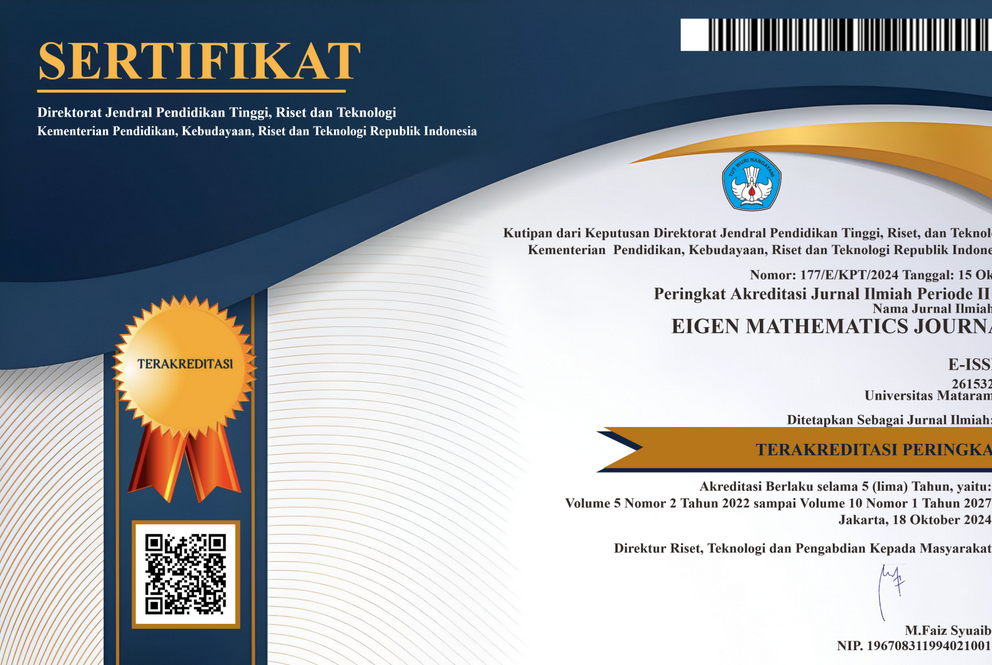Comparison Analysis of Clustering Methods for Clustering of Indonesian’s Gender Empowerment Conditions in 2022
DOI:
https://doi.org/10.29303/emj.v6i2.176Keywords:
cluster, gender, hierarchical methods, empowerment, partitioning methodsAbstract
Gender empowerment is one of the components of gender development achievement measures that is an important agenda at the global level in realizing the Sustainable Development Goals. The Gender Empowerment Index (GEI) of Indonesia has been continuously improving since 2010, indicating an increasing involvement of women in various areas of life. However, behind this upward trend in GEI, there is still inequality at the provincial level. Therefore, there is a need to formulate development strategies, one of which is gender-based. One possible step is to categorize regions in Indonesia based on their gender empowerment characteristics so that government interventions can be targeted effectively. This research utilizes two clustering approaches, namely Hierarchical Methods and Partitioning Methods, with data consisting of three variables representing the components of GEI for 34 provinces in Indonesia in 2022. The selection of the best method and number of clusters is based on internal and stability validity, followed by the determination of the smallest within and between standard deviation ratios. From the cluster analysis results, the best method is found to be K-means with a total of 5 clusters.References
Afira, N., & Wijayanto, A. W. (2021). Analisis Cluster dengan Metode Partitioning dan Hierarki pada Data Informasi Kemiskinan Provinsi di Indonesia Tahun 2019. Komputika : Jurnal Sistem Komputer, 10(2), 101–109. https://doi.org/10.34010/komputika.v10i2.4317
Astuti, C. C., & Rezania, V. (2022). Cluster Analysis for Grouping Districts in Sidoarjo Regency Based on Education Indicators. KnE Social Sciences, 2022(47), 311–317. https://doi.org/10.18502/kss.v7i10.11233
BPS. (2023). Indeks Pembangunan Gender.
Cornwall, A. (2016). Women’s Empowerment: What Works? Journal of International Development, 28(3), 342–359. https://doi.org/https://doi.org/10.1002/jid.3210
Diana, R. (2018). Analisis Ketimpangan Gender Di Provinsi Sumatera Barat (Gender Inequality Analysis in West Sumatera Province). 13(1), 55–66.
Halkidi, M., Batistakis, Y., & Vazirgiannis, M. (2001). On Clustering Validation Techniques. Intelligent Informatio Systems, 107–145. https://doi.org/10.1023/A
Hasanah, I. N. (2022). Analisis Cluster Berdasarkan Dampak Ekonomi di Indonesia Akibat Pandemi Covid-19. 10(02).
Jain, A. K., Murty, M. N., & Flynn, P. J. (1999). Data Clustering: A Review. 31, 264–323.
Johnson, R. A., & Winchern, Dean W. (2007). Applied Multivariate Statistical Analysis. In Applied Multivariate Statistical Analysis: Second Edition. https://doi.org/10.1007/978-3-540-72244-1
Judiasih, S. D. (2022). Implementasi Kesetaraan Gender Dalam Beberapa Aspek Kehidupan Bermasyarakat Di Indonesia. ACTA DIURNAL Jurnal Ilmu Hukum Kenotariatan, 5, 284–302.
Kara, F. (2021). Comparison of tree diameter distributions in managed and unmanaged Kazdağı fir forests.
Khairati, A. F., Adlina, A. ., Hertono, G. ., & Handari, B. . (2019). Kajian Indeks Validitas pada Algoritma K-Means Enhanced dan K-Means MMCA. PRISMA, Prosiding Seminar Nasional Matematika, 2, 161–170.
KPPA, & BPS. (2022). Pembangunan Manusia Berbasis Gender 2022.
Luthfi, E., & Wijayanto, A. W. (2021). Analisis Perbandingan Metode Hirearchical , K-means , dan K-medoids Clustering dalam Pengelompokkan Indeks Pembangunan Manusia. Inovasi, 17(4), 770–782.
Nisa, A. H. (2018). Pengelompokkan Kabupaten/Kota di Jawa Timur Berdasarkan Kondisi Disparitas Pembangunan Manusia Berbasis Gender. 97.
Nurfadilah, K. (2021). Analisis Cluster Longitudinal pada Pembangunan Manusia di Sulawesi Selatan Berbasis Gender. 9(1).
Porter, E. (2013). Rethinking Women’s Empowerment. Journal of Peacebuilding & Development, 8(1), 1–14. https://doi.org/https://doi.org/10.1080/15423166.2013.785657
Rafsanjani, M. K., Varzaneh, Z. A., Chukanlo, N. E., Rafsanjani, M. K., Varzaneh, Z. A., & Chukanlo, N. E. (2012). A survey of hierarchical clustering algorithms. 3(3), 229–240.
Rani, Y., & Rohil, H. (2013). A study of hierarchical clustering algorithms. International Journal of Information and Computation Technology, 3(11), 1225–1232.
Rencher, A. C. (2002). Methods of Multivariate Analysis. In Methods of Multivariate Analysis. https://doi.org/10.1002/0471271357
Salsabila, D., & Hendrawan, M. Y. (2021). Analisis Kondisi Pemberdayaan Gender di Indonesia Tahun 2020 dengan Agglomerative Hierarchical Clustering dan Biplot. 204–213.
Sukim, Firdaus, Retnaningsih, & Utami, E. D. (2018). Mengukur Kepemimpinan Perempuan di Indonesia dengan Metode Fuzzy c-Means Clustering. 18(2), 101–112.
Swarndepp, S. J., & Pandya, S. (2016). An Overview of Partitioning Algorithms in Clustering Techniques. International Journal of Advanced Research in Computer Engineering & Technology (IJARCET), 5(6), 1943–1946. http://itd.idaho.gov/ohs/2011Data/Analysis2011.pdf
Talakua, M. W., Leleury, Z. A., & Talluta, A. W. (2017). Analisis Cluster Dengan Menggunakan Metode K-means Untuk Pengelompokkan Kabupaten/ Kota di Provinsi Maluku Berdasarkan Indikator Indeks Pembangunan Manusia Tahun 2014. 11, 119–128.
Yedla, M., Pathakota, S. R., & M, S. T. (2010). Enhancing K-means Clustering Algorithm with Improved Initial Center. International Journal of Computer Science and Information Technologies, 1(2), 121–125.
Downloads
Published
How to Cite
Issue
Section
License

This work is licensed under a Creative Commons Attribution-NonCommercial-ShareAlike 4.0 International License.
All articles published in the Eigen Mathematics Journal will be available for free reading and downloading. The license applied to this journal is Creative Commons Attribution-Non-Commercial-Share Alike (CC BY-NC-SA).
Most read articles by the same author(s)
- Alvia Rossa Damayanti, Arie Wahyu Wijayanto, Comparison of Hierarchical and Non-Hierarchical Methods in Clustering Cities in Java Island using the Human Development Index Indicators year 2018 , EIGEN MATHEMATICS JOURNAL: Vol. 4 No. 1 Juni 2021






